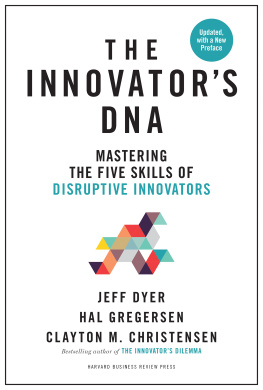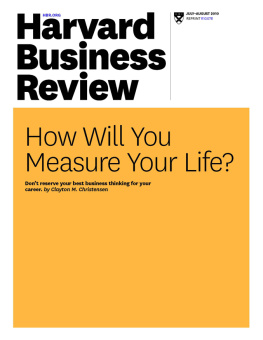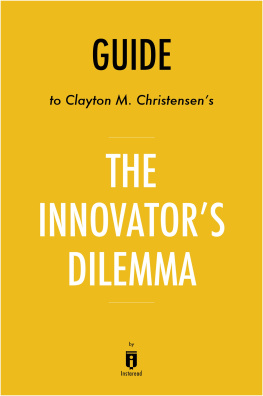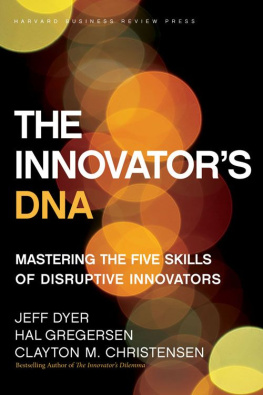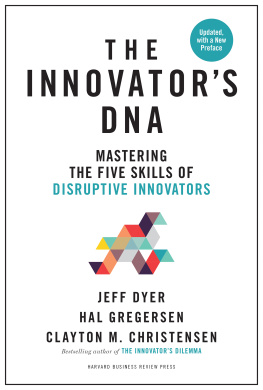2
Discovery Skill #1
Associating
Creativity is just connecting things.
Steve Jobs, founder and longtime CEO, Apple Inc.
INNOVATORS THINK DIFFERENTLY (to be grammatically correct), but as Steve Jobs put it, they really just think differently by connecting the unconnected. Einstein once called creative thinking combinatorial play and saw it as the essential feature in productive thought. Associatingor the ability to make surprising connections across areas of knowledge, industries, even geographiesis an often-taken-for-granted skill among the innovators we studied. Innovators actively pursue diverse new information and ideas through questioning, observing, networking, and experimentingthe key catalysts for creative associations.
To illustrate how associations produce innovative business ideas, consider how Marc Benioff came up with the idea for Salesforce, now a $100 billion software company. Benioffs experience with technology and software began when, as a fifteen-year-old, he built a small software company, Liberty Software, writing computer games (like How to Juggle) on his Commodore 64. As a computer-science and entrepreneurship undergraduate, Benioff worked summers at Apple during the buildup and launch of the first Mac, learning firsthand what it meant to work in a think-different world.
After graduation, Benioff joined Oracle, then a small startup. By the time Benioff was twenty-five, he was leading Oracles entire direct-marketing division and was beginning to see several streams of opportunity emerging on the internet. The nature of being successful with software is you always have to be looking for the next thing, so you have to condition your mind to think that way, Benioff told us. Ive seen a lot of different technological shifts over the last twenty-five years, so as I was sitting at my desk at Oracle in the late nineties and watching the emergence of Amazon and eBay... it felt like something significant was on the horizon.
Benioff decided it was time to think more deeply about the changing technological landscapeand his own career. So he took a sabbatical that started with a trip to India, where he met a variety of diverse people, including spiritual leader and humanitarian Mata Amritanandamayi (who helped strengthen his commitment to doing well and doing good in business). Benioffs next stop on this global journey was Hawaii, where he discussed various ideas for new businesses with an assortment of entrepreneurs and friends. While he was swimming with dolphins in the Pacific Ocean, the fundamental epiphany for Salesforce surfaced. He reflected: I asked myself Why arent all enterprise software applications built like Amazon and eBay? Why are we still loading and upgrading software the way that we have been doing all this time when we now have the internet? And that was a fundamental breakthrough for me, asking those questions. And thats the genesis of Salesforce. Its basically enterprise software meets Amazon.
Benioffs synthesis of novel inputs or associationsenterprise software meets Amazonchallenged the industry tradition of selling software on CD-ROMs and engaging companies in lengthy, customized (and expensive) installation processes, and instead focused on delivering software as a service over the internet. That way, the software would be available 24/7, and companies would avoid all the costs and shutdowns associated with ongoing, large-scale IT system installations and upgrades. Given his substantial experience in sales and marketing at Oracle, Benioff felt that providing software services for managing a sales force and customer relations carried huge potential for small and medium-sized businesses that couldnt afford customized enterprise software. Thus, Salesforce was born.
Benioffs vision emerged from years of significant software-industry experience combined with countless questions, observations, explorations, and conversations that ultimately helped him bring together things that had never been connected before. He borrowed elements of the Amazon business model and built a different one based on a software system that companies would pay for as they used it, instead of paying for all of the software systems before they used them (as most software providers required). It was truly revolutionary, as it launched an era of cloud computing that seems obvious now but was far from obvious then.
Ever the juggler with a mind hooked on combinatorial play (or playing around with new associations), Benioff has continued the innovation journey, along with his Salesforce team. He explained that pre-Salesforce, his critical question was Why isnt all enterprise software like Amazon? but post-Salesforce, a different question slowly took its place: Why isnt all enterprise software (including Salesforce) like Facebook? Benioff and his team hotly pursued the answer and invented Chatter, a new social-software application that has been referred to as Facebook for businesses. Chatter takes the best of Facebook and Twitter and applies it to enterprise collaboration. (Think of it as Facebook and Twitter meet enterprise software, just as enterprise software met Amazon at Salesforces genesis.)
Chatter uses new ways of sharing information, such as feeds and groups, so that without any effort people can see what individuals and teams are focusing on, how projects are progressing, and what deals are closing. It changes the way companies collaborate on product development, customer acquisition, and content creation by making it easy for everyone to see what everyone else is doing. At companies using Chatter, inboxes have shrunk dramatically (by 43 percent at Salesforce), because the majority of communications are now status updates and feeds in Chatter. Employees now follow accounts, and updates are automatically broadcast to them in real time via Chatter, Benioff told us. This is the true power of Chatterbringing to light the most important people and ideas that move our companies forward. I call this social intelligence, and its giving everyone access to the people, the knowledge, and the insight they need to make a difference.
Associating: What It Is
The great innovative entrepreneur Walt Disney once described his role in the company he founded as creative catalyst. By that he meant that while he himself didnt actually do the drawings for the wonderful animated films or build the giant Matterhorn replica for Disneyland, he did put ideas together in ways that sparked creative insights throughout the company. One day, a little boy was curious about Disneys job, and Disney vividly recalled the conversation: I was stumped one day when a little boy asked, Do you draw Mickey Mouse? I had to admit I do not draw any more. Then you think up all the jokes and ideas? No, I said, I dont do that. Finally, he looked at me and said, Mr. Disney, just what do you do? Well, I said, I think of myself Not only did Disney spark others ideas, he sparked his own as well by putting himself at the intersection of others experiences. Over time, Disneys associational insightsincluding a string of industry firsts such as joining animation with full-length movies and putting themes into amusement parkschanged the face of entertainment.
Innovative leaders at well-known companies such as Apple, Amazon, and Tesla do exactly the same thing. They cross-pollinate ideas in their own heads and in others. They connect wildly different ideas, objects, services, technologies, and disciplines to dish up new and unusual innovations. Its very helpful to cross-fertilize ideas from different industries, Teslas Elon Musk told us. Sometimes a solution from one industry can apply to a different industry. That can be really powerful. Musk continued by giving an example: Tesla has borrowed ideas freely from SpaceX, including its extensive use of aluminum in both the body and chassis of the Model S, as well as drawing and casting techniques used to produce the aluminum bodies of SpaceXs Falcon rocket... This is critical to keeping the car as light as possible. This is how innovators think differently, or what we call associating, a cognitive skill at the core of the innovators DNA. In this chapter, we look more deeply into the workings of associational thinking and offer some techniques for developing this cognitive ability.

